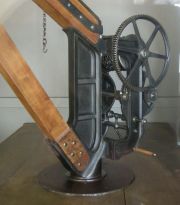
François Cavé (1794-1875) was a French engineer.
In 1826 he opened his own workshops in the Goutte-d'Or district. Products included: machine tools, locomotives, ships, marine engines, stationary steam engines, presses. His son-in-law, Louis Lemaître, ran the adjoining factory at La Chapelle Saint-Denis.
He was born on 12 September 1794 to poor agricultural labourers. After military service, he went to work for John Collier at the rue Richer in Paris. He then became a foreman in a spinning mill in the Clignancourt, where he designed an oscillating engine to replace an existing steam engine. In 1828 he built the machinery for the cross-channel steamer Courrier, which had feathering paddles.[1]
The Musée des arts et métiers have on display a scale model of a Cavé 20 tonne crane ordered by a British railway contractor for the compagnie de chemin de fer du Paris-Orléans. The model was made c.1841 by Pierre Clair.[2]
1843 Large planing machine described and illustrated here and adjacent pages [3]
See Also
Sources of Information
- ↑ 'A History of Technology and Invention', edited by Maurice Daumas, translated from French by Eileeen B. Hennessy
- ↑ [1] Musée des arts et métiers: Modèle : Grue de Cavé
- ↑ [2] Bulletin de la Société d'Encouragement pour l'Industrie Nationale, 1843, 42nd year, N. 463-474, Machine à outils mobiles destinée à raboter et dresser les grandes pièces métalliques, employée dans les ateliers de M. Cavé

